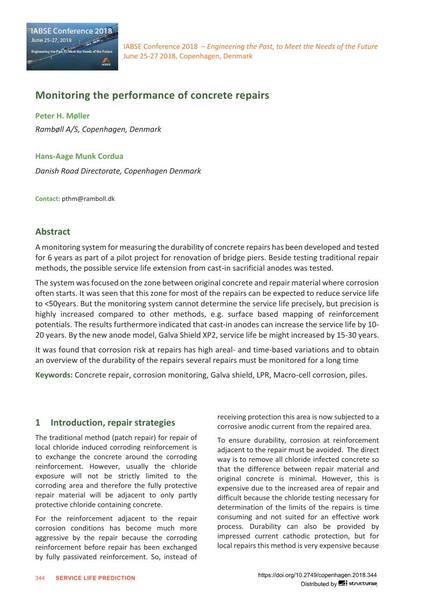Monitoring the performance of concrete repairs

|
|
|||||||||||
Bibliographic Details
| Author(s): |
Peter H. Møller
(Rambøll A/S, Copenhagen, Denmark)
Hans-Aage Munk Cordua (Danish Road Directorate, Copenhagen Denmark) |
||||
|---|---|---|---|---|---|
| Medium: | conference paper | ||||
| Language(s): | English | ||||
| Conference: | IABSE Conference: Engineering the Past, to Meet the Needs of the Future, Copenhagen, Denmark, 25-27 June 2018 | ||||
| Published in: | IABSE Conference Copenhagen 2018 | ||||
|
|||||
| Page(s): | 344-351 | ||||
| Total no. of pages: | 8 | ||||
| DOI: | 10.2749/copenhagen.2018.344 | ||||
| Abstract: |
A monitoring system for measuring the durability of concrete repairs has been developed and tested for 6 years as part of a pilot project for renovation of bridge piers. Beside testing traditional repair methods, the possible service life extension from cast-in sacrificial anodes was tested. The system was focused on the zone between original concrete and repair material where corrosion often starts. It was seen that this zone for most of the repairs can be expected to reduce service life to<50years. But the monitoring system cannot determine the service life precisely, but precision is highly increased compared to other methods, e.g. surface based mapping of reinforcement potentials. The results furthermore indicated that cast-in anodes can increase the service life by 10- 20 years. By the new anode model, Galva Shield XP2, service life be might increased by 15-30 years. It was found that corrosion risk at repairs has high areal- and time-based variations and to obtain an overview of the durability of the repairs several repairs must be monitored for a long time. |
||||
| Keywords: |
corrosion monitoring piles concrete repair Galva shield LPR Macro-cell corrosion
|
||||
